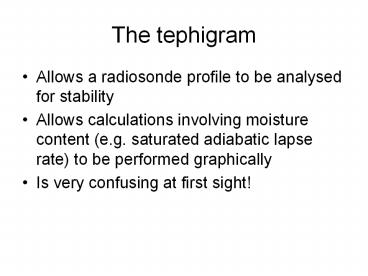The tephigram - PowerPoint PPT Presentation
Title:
The tephigram
Description:
The tephigram. Allows a radiosonde profile to be analysed for stability. Allows calculations involving moisture content (e.g. saturated adiabatic lapse ... – PowerPoint PPT presentation
Number of Views:518
Avg rating:3.0/5.0
Title: The tephigram
1
The tephigram
- Allows a radiosonde profile to be analysed for
stability - Allows calculations involving moisture content
(e.g. saturated adiabatic lapse rate) to be
performed graphically - Is very confusing at first sight!
2
Basic idea
- Plot temperature as x-axis and entropy as y
- dS cpdln? so we plot temperature versus ln?
3
Adding pressure
Our measurements are of temperature and pressure,
so we want to represent pressure on the plot. The
curved lines are isopleths of constant pressure,
in mb.
4
Rotating plot and plotting profile
The diagram is rotated through 45 so that the
pressure lines are quasi-horizontal
Temperature and Dew point are plotted on the
diagram. Dew point is simply plotted as a
temperature. Here
Pressure, mb Temp., C Dew point, C
1000 20 15
900 10 9
850 11 5
700 0 -15
500 -25 -40
300 -50 -55
200 -60
100 -60
5
Adding Moisture information
- Dew point is a measure of moisture content. The
tephigram can be used to convert (TD,T) to mixing
ratio - Mass mixing ratio isopleths are light dashed
lines. Units are g kg-1 - Curved lines are saturated adiabats the path a
saturated parcel of air follows on adiabatic
ascent
6
Saturated adiabatic
ConstantMixing ratio
7
Example 1
Pressure, mb Temp., C Dew point, C
1000 7 6
920 7 7
870 6 0
840 3.5 -1.5
700 -8 -16
500 -27 -36
300 -58
250 -67
200 -65
Tropopause
Inversion layer
Saturated air (T TD)
8
Example 2
Pressure, mb Temp., C Dew point, C
1000 8.5 5.5
860 0.5 -3
710 -8 -17
550 -21.5 -31.5
490 -22.5 -45
330 -45
285 -51
200 -51
Tropopause
Frontal Inversion layer





























